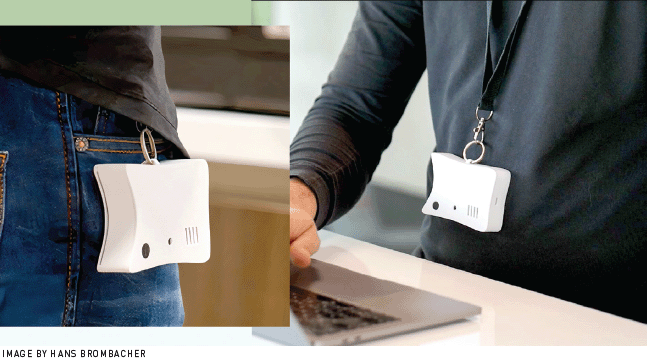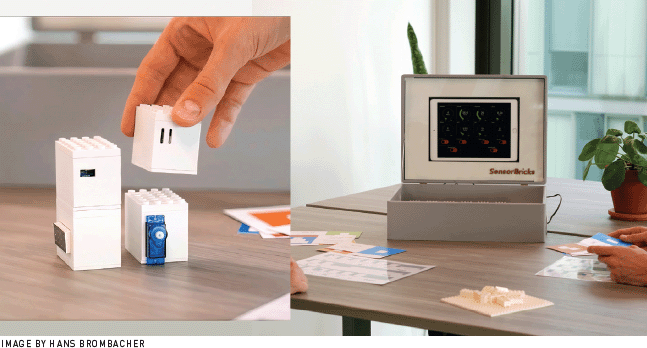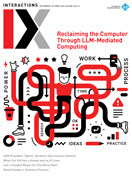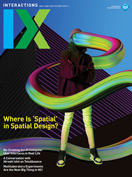Authors:
Hans Brombacher, Steven Vos, Steven Houben
The modern office has never been smarter. Building management systems adjust lighting and temperature based on occupancy patterns. Dashboards and digital platforms provide real-time metrics on air quality, productivity, and energy efficiency. Wearable devices track steps, posture, and stress levels. On the surface, it appears that technology is poised to solve many of the discomforts and inefficiencies that plague office environments. Yet, despite these advancements, office workers continue to experience stress, discomfort, and disengagement. In 2022, a survey across 15 countries found that, on average, one in four employees reported experiencing symptoms of burnout, highlighting the widespread and international scope of the issue (http://bit.ly/45tBG23). Hybrid work models, open-plan offices, and constant digital connectivity have introduced new complexities, making it increasingly difficult to foster environments that truly support well-being.
While smart technologies offer the promise of optimized workplaces, they often compromise factors such as autonomy, transparency, and meaningful engagement [1]. Many systems are developed with a primary focus on efficiency, frequently positioning employees as passive recipients of data-driven decisions rather than active participants in shaping their environment. These tools tend to function as "black boxes," where data is collected, processed, and acted upon without offering workers clear insight into the process or opportunities for interaction [2]. In response to these limitations, emerging design approaches emphasize interactive, tangible, and human-centered interventions. Moving beyond traditional dashboards and passive sensor systems, such approaches aim to actively involve workers in making sense of their well-being data and in influencing their workplace conditions. Through the use of wearable sensor systems, collaborative tools, and physicalized data representations, these strategies highlight how data can be rendered more visible, situated, and actionable within the daily context of office life [1].
→ Office well-being technologies must balance automation, transparency, and user autonomy.
→ Tangible and situated tools enable meaningful, human-centered engagement beyond traditional dashboards.
→ Flexible infrastructures should accommodate diverse user needs and adapt to evolving workplace practices.
In this article, we outline seven challenges that designers and researchers must address to create healthier, more human-centered workplaces. These challenges draw on real-world studies conducted in office environments and with office workers, emphasizing tensions such as automation versus autonomy, transparency versus privacy, and digital overload versus meaningful engagement. These challenges were developed by synthesizing insights from our prior design research in office settings [1,3]. This included field observations, participatory design sessions, and deployments of sensor-based well-being interventions. Across these studies, we observed recurring tensions in how workers experience and interact with well-being technologies, which we distilled into the seven challenges presented here. Rather than prescribing one-size-fits-all solutions, we invite designers, researchers, and decision-makers to reflect not only on the challenges shaping office well-being but also on how these challenges might be addressed through more participatory, transparent, and flexible design approaches.
 Challenge 1: Automation vs. Autonomy
Challenge 1: Automation vs. Autonomy
Automation has become a hallmark of modern office environments, with systems designed to automatically adjust environmental factors such as lighting, temperature, and ventilation based on occupancy patterns and energy optimization algorithms. While such automation increases operational efficiency and can contribute to comfort at scale, it often reduces the sense of personal control workers have over their immediate surroundings [4]. This tension is particularly evident in smart buildings, where workers may find themselves subjected to predetermined environmental conditions with little ability to override or customize settings. This leads to what we have termed "fake control"—situations where interfaces appear to offer users choice or influence, but ultimately defer to automated, centrally managed systems. Such constrained interaction undermines user agency, resulting in frustration, disengagement, and diminished trust in the system. For example, employees reported dissatisfaction when temperature and lighting settings were automatically adjusted without considering individual preferences or providing clear feedback mechanisms. The rigid nature of these systems often fails to account for the diversity of worker needs, especially in shared office spaces with varying comfort thresholds [1].
Striking the right balance between automated optimization and human agency remains a critical design consideration for the next generation of smart office technologies.
Addressing this challenge requires rethinking how automation is balanced with autonomy. Systems should be designed to offer meaningful control to individuals, providing intuitive ways to adjust or negotiate environmental conditions. This might involve integrating lightweight, tangible controls—such as personal climate devices or adjustable lighting modules—that allow workers to override or fine-tune automated settings without disrupting overall system efficiency. Furthermore, interfaces should clearly communicate how automated decisions are made and where users have opportunities to intervene, supporting transparency alongside flexibility. By moving away from fully centralized automation and incorporating participatory elements, designers can foster a greater sense of ownership and well-being among office workers. Striking the right balance between automated optimization and human agency remains a critical design consideration for the next generation of smart office technologies.
 Challenge 2: Transparency vs. Privacy
Challenge 2: Transparency vs. Privacy
The integration of sensor systems and data-driven platforms in offices often brings heightened concerns around privacy, transparency, and surveillance. While collecting data on environmental conditions and workplace behaviors can yield valuable insights for optimizing office well-being, these systems frequently lack clarity regarding what data is collected, how it is used, and who has access to it [1]. Office workers are often unaware of when they are being monitored or how the data collected affects decisions about their environment. This opaqueness results in what has been described as black box systems—technologies that gather and process data invisibly, leaving users with little understanding of their role in the system [2]. Such systems risk eroding trust and contributing to feelings of disempowerment, particularly when data collection encroaches on personal behaviors without explicit consent or clear benefit to the individual.
To address this challenge, transparent data practices must be prioritized. Design strategies should include clear communication about which data is collected, why it is collected, and how it will be used. Interfaces can visualize data and allow users to inspect, question, or control the data being gathered [4]. For example, wearable sensor systems designed with ego-centric sensing principles give users direct access to their data, offering opportunities to engage with and interpret personal environmental and well-being metrics on their own terms [1]. Additionally, designers must balance the value of collective, aggregated data insights with individual privacy rights. Mechanisms such as opt-in participation, anonymization, and granular consent options help ensure that workers retain control over their data while benefiting from broader workplace insights. Transparency not only addresses ethical considerations but also fosters a more open, participatory relationship between office workers and the technologies intended to support their well-being.
 Challenge 3: Digital Overload vs. Meaningful Engagement
Challenge 3: Digital Overload vs. Meaningful Engagement
The contemporary office environment is saturated with digital interfaces—email, messaging platforms, dashboards, and various monitoring systems. While these tools provide constant streams of information, they often contribute to display and notification overload [5]. The introduction of well-being interventions through yet another screen-based dashboard or app risks being overlooked or ignored, and it can even add to the problem rather than solving it [6]. Studies on digital well-being interventions highlight limitations such as low engagement, display blindness, and reduced recall of information presented via standard screen interfaces. Workers already immersed in digital workflows may perceive these interventions as intrusive or as an additional layer of complexity, diminishing their effectiveness.
One promising strategy to mitigate this challenge involves shifting away from purely digital solutions and exploring more tangible, ambient, and peripheral modes of engagement. For example, physical artifacts or situated displays can embed well-being data directly into the physical workspace, reducing reliance on active attention while maintaining a presence in workers' awareness [4,6]. Systems that leverage light, movement, and other subtle cues allow information to be accessed at a glance, supporting reflection without demanding constant focus. Additionally, providing multimodal, flexible interaction options—such as combining physical tools with mobile or desktop interfaces—can cater to varying preferences and contexts. Ensuring that data is presented in digestible, nonintrusive formats helps create more meaningful and sustained engagement [4]. By moving beyond the dominance of screens and considering how interventions integrate naturally into the physical and social fabric of the office, designers can avoid contributing to digital overload while supporting healthier, more attentive work environments.
 | SensorBadge is an ego-centric, portable sensing device that allows workers to monitor and reflect on their immediate environmental conditions, supporting autonomy and control across flexible and hybrid work settings [1]. |
 | SensorBricks is a tangible tool kit that enables office workers to explore, manipulate, and make sense of well-being data directly within their physical workspace, moving beyond traditional dashboards [4]. |
 Challenge 4: Personalization vs. One-Size-Fits-All Systems
Challenge 4: Personalization vs. One-Size-Fits-All Systems
Office environments are typically designed around standardized conditions intended to serve the majority of occupants. However, individual differences in comfort preferences, work styles, and sensitivities to environmental factors such as noise, temperature, lighting, and air quality are significant. A system optimized for averages often fails to account for these variations, leading to dissatisfaction and diminished well-being for those whose needs fall outside the assumed norm. This challenge becomes particularly pronounced in shared or open-plan offices, where diverse preferences coexist within the same space [6]. Fixed environmental settings—such as uniform temperature or lighting levels—may inadvertently prioritize operational efficiency over individual comfort. Similarly, generalized well-being interventions often neglect personal factors, such as physical activity levels, stress thresholds, and work habits, resulting in generic solutions with limited relevance.
To address this, systems must be designed with flexibility and personalization at their core. Egocentric sensing approaches, for example, enable individualized monitoring through wearable or portable devices, allowing workers to collect data specific to their immediate environment and behavior [1]. Such personalized systems not only acknowledge individual differences but also empower users to tailor interventions to their unique needs. Providing adjustable, modular elements—such as localized climate controls, customizable lighting, or flexible data representations—can further support inclusivity. Beyond technical adaptability, involving workers in the design process helps ensure that interventions reflect a wide range of preferences and lived experiences. Recognizing and designing for individual variability is essential to moving beyond one-size-fits-all approaches and fostering inclusive, supportive workplaces that accommodate the full spectrum of worker needs.
 Challenge 5: Data Literacy Gaps
Challenge 5: Data Literacy Gaps
As sensor technologies and data-driven systems become increasingly embedded in office environments, workers are frequently presented with data related to their well-being, ranging from environmental metrics to behavioral insights [3]. The ability to interpret, contextualize, and act upon this information, however, is not evenly distributed. Many well-being interventions assume a level of data literacy that users may not possess, limiting the potential for informed decision making and meaningful engagement. Without adequate support, well-being data risks remain abstract, inaccessible, and misinterpreted. Workers may struggle to understand the relevance of metrics such as CO2 levels, light levels, and humidity, particularly when they are presented in unfamiliar formats or without sufficient context [4]. This disconnect can result in low engagement, skepticism, or disengagement from well-being initiatives.
Recognizing and designing for individual variability is essential to moving beyond one-size-fits-all approaches and fostering inclusive, supportive workplaces.
One approach to bridging this gap involves integrating educational and interpretive elements into system design. Physicalization techniques—transforming digital data into tangible, interactive artifacts—can enhance comprehension by allowing users to explore and manipulate data directly [4]. For instance, tangible tool kits that visualize environmental conditions or activity patterns can demystify complex datasets, making information more approachable and intuitive.
Additionally, providing comparative references, trend visualizations, or simple cues about recommended actions can support users in making sense of their data. Facilitating collaborative exploration—where teams collectively interpret and reflect on shared well-being data—further reinforces learning and promotes a culture of openness and literacy. Addressing data literacy is not solely about simplifying interfaces. It is also about equipping users with the confidence and understanding to engage critically with the information shaping their work environments [4]. Systems that support incremental learning, contextual understanding, and accessible interaction play a vital role in making well-being data actionable and empowering.
 Challenge 6: Situated Data Sensemaking
Challenge 6: Situated Data Sensemaking
Well-being data in office environments is often delivered through detached, abstract interfaces, such as dashboards and mobile applications, that are positioned outside the context of workers' daily routines [6]. While these systems provide access to information, they frequently fail to connect the data to the specific physical, social, and temporal circumstances in which it is relevant. This separation limits opportunities for reflection, immediate action, and long-term behavior change. Situated data sensemaking addresses this challenge by embedding data representations directly within the spaces and situations where well-being decisions are made. Rather than requiring users to consult external interfaces, data is presented in the flow of everyday activities, seamlessly integrated into the environment. This approach aligns with principles of embodied interaction, recognizing that understanding and meaning emerge through engagement with the physical world.
Examples of situated sensemaking include ambient displays that visualize air quality and activity levels in communal areas, or physical artifacts placed on desks that reflect real-time environmental conditions. Such interventions allow workers to encounter and interpret well-being data informally, without disrupting focus or requiring deliberate attention. Moreover, when data representations are made visible and accessible to groups, they can support collaborative reflection. Office workers are able to discuss, compare, and collectively act on shared information—fostering not only individual awareness but also team-level responsibility for well-being. Situated sensemaking can operate at different scales—from individual workstations to shared spaces and entire office zones—each of which offers unique opportunities for localized or collective engagement with well-being data.
Designing for situated sensemaking requires careful consideration of context, visibility, and subtlety. Data must be presented in ways that are noticeable yet nonintrusive, inviting interpretation while respecting workflow and personal boundaries. By embedding well-being data into the lived environment, designers can transform abstract information into tangible, actionable insights grounded in the realities of everyday office life.
 Challenge 7: Constrained Infrastructures vs. Meaningful Flexibility
Challenge 7: Constrained Infrastructures vs. Meaningful Flexibility
Smart office technologies are often built upon rigid, centralized infrastructures—centralized HVAC systems, fixed sensor grids, and standardized data platforms—designed primarily to serve operational goals, such as energy efficiency or occupancy management [3]. While efficient, these infrastructures introduce "constrained possibilities," limiting workers' ability to adjust, personalize, or adapt their environment in real time to support their well-being needs. Office workers frequently encounter friction when attempting to engage with these systems. For example, interfaces may offer only superficial control options (such as temperature presets), leaving individuals unable to meaningfully influence their surroundings. Furthermore, infrastructures are rarely designed to adapt to dynamic, hybrid work patterns, making them less effective in flexible workplaces where individuals move between home, office, and shared spaces.
To address this challenge, designers must rethink the assumptions of office infrastructures. Systems should allow for modularity, adaptability, and user-driven customization, enabling interventions that can flex with workers' changing contexts. Introducing ego-centric sensing platforms—such as wearable or mobile tools—allows workers to carry control and insight across different locations, reducing dependency on static, centralized systems. Moreover, designing infrastructures with openness in mind—supporting interoperability, data portability, and real-time user feedback—fosters meaningful flexibility. By loosening rigid constraints and prioritizing modular, adaptable infrastructures, office technologies can better accommodate the diversity and dynamism of modern work, contributing more effectively to worker well-being.
 Conclusion: Designing for Human-Centered Office Well-Being
Conclusion: Designing for Human-Centered Office Well-Being
As workplaces continue to evolve, shaped by hybrid models, smart technologies, and shifting organizational priorities, the need for thoughtful, human-centered approaches to office well-being becomes increasingly urgent. While advancements in automation, data collection, and optimization offer new possibilities, they also introduce challenges related to autonomy, privacy, engagement, and inclusivity. This article has outlined seven design challenges that technologists, researchers, and decision makers must address to create healthier, more supportive office environments. These include balancing automation with autonomy, ensuring transparency while safeguarding privacy, mitigating digital overload, and accommodating individual variability. Equally important is the need to bridge data literacy gaps, embed well-being information within the lived context of the workplace, and move beyond short-term metrics toward long-term well-being strategies.
Addressing these challenges requires rethinking how technologies engage office workers—not merely as data points within automated systems, but as active participants with diverse needs, preferences, and capacities for interpretation. Interactive, tangible, and situated interventions offer promising pathways to foster agency, understanding, and collaboration. Ultimately, designing for office well-being is not solely a question of technological sophistication but of aligning systems with the human experience of work. By foregrounding participation, transparency, and adaptability, designers can contribute to workplaces that are not only efficient but also genuinely supportive of the people within them.
1. Brombacher, H., Houben, S., and Vos, S. SensorBadge: An exploratory study of an ego-centric wearable sensor system for healthy office environments. Proc. of the 2022 Designing Interactive Systems Conference. ACM, 2022, 1863–1877; http://bit.ly/4jYtytV
2. Mortier, R., Haddadi, H., Henderson, T., McAuley, D., and Crowcroft, J. Human-data interaction: The human face of the data-driven society. arXiv:1412.6159, Oct. 6, 2014.
3. Brombacher, H., Van Koningsbruggen, R., Vos, S., and Houben, S. SensorBricks: A collaborative tangible sensor toolkit to support the development of data literacy. Proc. of the Eighteenth International Conference on Tangible, Embedded, and Embodied Interaction. ACM, 2024, Article 30, 1–17; http://bit.ly/464JqaT
4. Edwards, W.K., Newman, M.W., and Shehan Poole, E. The infrastructure problem in HCI. Proc. of the SIGCHI Conference on Human Factors in Computing Systems. ACM, 2010, 423–432; http://bit.ly/4n5op5U
5. Müller, J. et al. Display blindness: The effect of expectations on attention towards digital signage. In Pervasive Computing. H. Tokuda, M. Beigl, A. Friday, A.J. Bernheim Brush, and Y. Tobe, eds. Lecture Notes in Computer Science, LNCS 5538. Springer, 2009, 1–8.
6. Brombacher, H., Houben, S., and Vos, S. Tangible interventions for office work well-being: Approaches, classification, and design considerations. Behaviour & Information Technology 43, 10 (2024), 2151–2175; http://bit.ly/45usF8N
Hans Brombacher is a design researcher at Eindhoven University of Technology. His work focuses on human-data interaction, data physicalization, and tangible tools to support well-being in office environments. He explores how interactive systems can translate complex data into meaningful, human-centered insights and actions. [email protected]
Steven Vos is a full professor at Eindhoven University of Technology and Fontys University of Applied Sciences. His research focuses on human movement sciences and behavioral sciences, with an emphasis on the design of technology-supported interventions to promote physical activity and well-being. [email protected]
Steven Houben is an associate professor in HCI at Eindhoven University of Technology. His research focuses on physical and ubiquitous computing systems. His work explores physicalizing human-data interaction to support "from sensor to physicalization" and study new cocreation processes, concepts, interaction paradigms, and data embodiments for nonexpert human-data/AI interaction. [email protected]
 This work is licensed under Creative Commons Attribution International 4.0.
This work is licensed under Creative Commons Attribution International 4.0.
The Digital Library is published by the Association for Computing Machinery. Copyright © 2025 ACM, Inc.







Post Comment
No Comments Found